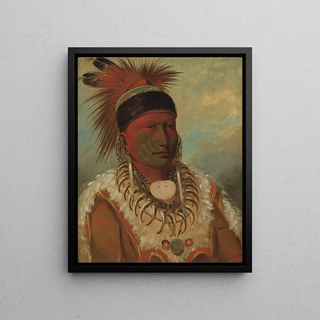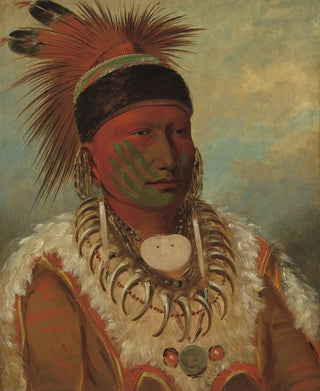Art print | The White Cloud Chief of the Iowas - George Catlin


View from behind

Frame (optional)
In the fascinating world of art, some works stand out for their ability to capture the essence of a particular era and culture. "The White Cloud Chief of the Iowas" by George Catlin is one of these iconic pieces, offering a poignant glimpse into the lives of Native American peoples. This painting, through its composition and subject, transports us to the heart of the traditions and struggles of the Iowas, a people whose history deserves to be told. Through this art print, viewers are invited to immerse themselves in a visual narrative that evokes both the beauty and melancholy of a changing world.
Style and uniqueness of the work
Catlin's work is characterized by a realistic and empathetic approach. In "The White Cloud Chief of the Iowas," he depicts a Native leader with meticulous attention to detail, both in facial features and in the traditional ornaments that surround him. The vibrant colors and delicate nuances pay tribute to the cultural richness of the Iowas, while the majestic posture of the chief evokes undeniable dignity. The way Catlin uses light and shadow to create depth gives this art print an almost living dimension, allowing viewers to feel the intensity of the moment. By capturing not only the physical appearance of the subject but also his spirit and character, Catlin succeeds in establishing a strong emotional connection with the audience.
The artist and his influence
George Catlin, born in 1796, was much more than a painter; he was a pioneer in documenting Native American cultures. His commitment to faithfully representing indigenous peoples stemmed from his desire to preserve their heritage at a time when their existence was threatened by colonial expansion. Catlin traveled across the United States, meeting various tribes and striving to capture their way of life through his works. His artistic approach, marked by a unique sensitivity, not only enriched the artistic landscape of his time but also paved the way for a better understanding of Native American cultures. Today, his work continues to inspire generations of

Matte finish

View from behind

Frame (optional)
In the fascinating world of art, some works stand out for their ability to capture the essence of a particular era and culture. "The White Cloud Chief of the Iowas" by George Catlin is one of these iconic pieces, offering a poignant glimpse into the lives of Native American peoples. This painting, through its composition and subject, transports us to the heart of the traditions and struggles of the Iowas, a people whose history deserves to be told. Through this art print, viewers are invited to immerse themselves in a visual narrative that evokes both the beauty and melancholy of a changing world.
Style and uniqueness of the work
Catlin's work is characterized by a realistic and empathetic approach. In "The White Cloud Chief of the Iowas," he depicts a Native leader with meticulous attention to detail, both in facial features and in the traditional ornaments that surround him. The vibrant colors and delicate nuances pay tribute to the cultural richness of the Iowas, while the majestic posture of the chief evokes undeniable dignity. The way Catlin uses light and shadow to create depth gives this art print an almost living dimension, allowing viewers to feel the intensity of the moment. By capturing not only the physical appearance of the subject but also his spirit and character, Catlin succeeds in establishing a strong emotional connection with the audience.
The artist and his influence
George Catlin, born in 1796, was much more than a painter; he was a pioneer in documenting Native American cultures. His commitment to faithfully representing indigenous peoples stemmed from his desire to preserve their heritage at a time when their existence was threatened by colonial expansion. Catlin traveled across the United States, meeting various tribes and striving to capture their way of life through his works. His artistic approach, marked by a unique sensitivity, not only enriched the artistic landscape of his time but also paved the way for a better understanding of Native American cultures. Today, his work continues to inspire generations of






